Table of Contents
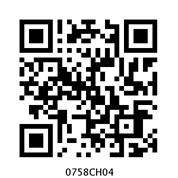
4. Heat
In Chapter 3 you learnt that woollen clothes are made from animal fibres. You also know that cotton clothes are made from plant fibres. We wear woollen clothes during winters when it is cold outside. Woollen clothes keep us warm. We prefer to wear light coloured cotton clothes when it is hot. These give us a feeling of coolness. You might have wondered why particular types of clothes are suitable for a particular season.
In winter you feel cold inside the house. If you come out in the sun, you feel warm. In summer, you feel hot even inside the house. How do we know whether an object is hot or cold? How do we find out how hot or cold an object is? In this chapter we shall try to seek answers to some of these questions.
4.1 Hot and Cold
In our day-to-day life, we come across a number of objects. Some of them are hot and some of them are cold. Tea is hot and ice is cold. List some objects you use commonly in Table 4.1. Mark these objects as hot or cold.
Table 4.1: Hot and cold objects
| Ojects | Cold/Cool | Warm/Hot |
| Ice Cream | ||
| Spoon in a tea cup | ||
| Fruit juice | ||
| Handle of a frying pan |
Do not touch objects which are too hot. Be careful while handling a candle flame or a stove. |
We see that some objects are cold while some are hot. You also know that some objects are hotter than others while some are colder than others. How do we decide which object is hotter than the other? We often do it by touching the objects. But is our sense of touch reliable? Let us find out.
Activity 4.1
Take three small tubs/containers. Label them as A, B and C. Put cold water in container A and hot water in container B. Mix some cold and hot water in container C. Now dip your left hand in container A and the right hand in container B. After keeping the hands in the two containers for 2–3 minutes, put both the hands simultaneously in container C (Fig. 4.1). Do both the hands get the same feeling?
Make sure that water is not so hot that you burn your hand |
Boojho’s confusion shows that we cannot always rely on our sense of touch to decide whether an object is hot or cold. Sometimes it may deceive us.
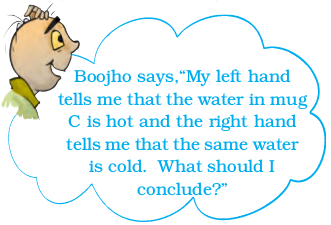
Then, how do we find out how hot an object really is? A reliable measure of the hotness of an object is its temperature. Temperature is measured by a device called thermometer.
4.2 Measuring Temperature

A clinical thermometer consists of a long, narrow, uniform glass tube. It has a bulb at one end. This bulb contains mercury. Outside the bulb, a small shining thread of mercury can be seen.
If you do not see the mercury thread, rotate the thermometer a bit till you see it. You will also find a scale on the thermometer. The scale we use is the celsius scale, indicated by °C.
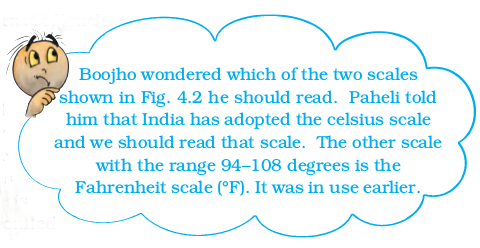
A clinical thermometer reads temperature from 35°C to 42°C.
Activity 4.2
Reading a thermometer
 .
.| Precautions to be observed while using a clinical thermometer |
|
Wash the thermometer, preferably with an antiseptic solution. Hold it firmly and give it a few jerks. The jerks will bring the level of mercury down. Ensure that it falls below 35°C. Now place the bulb of the thermometer under your tongue. After one minute, take the thermometer out and note the reading. This is your body temperature. The temperature should always be stated with its unit, °C.
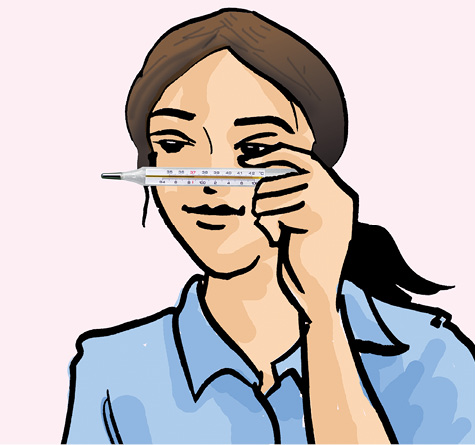
Fig. 4.3 Correct method of reading a clinical thermometer
What did you record as your body temperature?
The normal temperature of human body is 37°C. Note that the temperature is stated with its unit.

Let us try to assure Paheli that there is nothing wrong with her.
Activity 4.3
Measure the body temperature of some of your friends (at least 10) with a clinical thermometer. Record your observations as in Table 4.2.
| Name | Temperature(°C) |
Is the body temperature of every person 37°C?
The temperature of every person may not be 37°C. It could be slightly higher or slightly lower. Actually, what we call normal temperature is the average body temperature of a large number of healthy persons.
The clinical thermometer is designed to measure the temperature of human body only. The temperature of human body normally does not go below 35oC or above 42oC. That is the reason
that this thermometer has the range 35°C to 42°C.
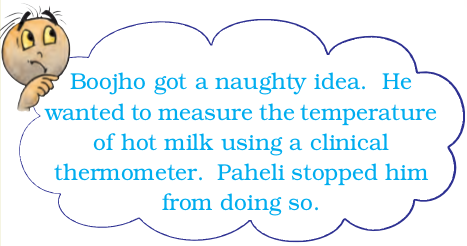
| CAUTION |
| Do not use a clinical thermimeter for measuring the temperature of any object other than the human body. Also avoid keeping the thermometer in the sun or near a flame. It may break. |
4.3 Laboratory Thermometer
Different types of thermometers are used for different purposes. The maximum and minimum temperatures of the previous day, reported in weather reports, are measured by a thermometer called the maximum-minimum thermometer. |
Let us now learn how this thermometer is used.
Activity 4.4
Take some tap water in a beaker or a mug. Dip the thermometer in water so that the bulb is immersed in water but does not touch the bottom or the sides of the container. Hold the thermometer vertically (Fig. 4.5). Observe the movement of mercury in the thermometer. Wait till the mercury thread becomes steady. Note the reading. This is the temperature of water at that time.
In addition to the precautions to be taken while reading a clinical thermometer, the laboratory thermometer
|
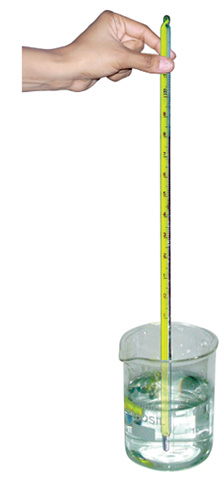
Compare the temperature of water recorded by each student in the class. Are there any variations in the readings? Discuss the possible reasons.
Let us try to answer this question.
Activity 4.5
Take some hot water in a beaker or a mug. Dip the thermometer in water. Wait till the mercury thread becomes steady and note the temperature. Now take out the thermometer from water. Observe carefully what happens now. Do you notice that as soon as you take the thermometer out of water, the level of mercury begins to fall. This means that the temperature must be read while the thermometer is in water.
You may recall that while taking your own temperature, you have to take the thermometer out of your mouth to note the reading. Can you then use the laboratory thermometer to measure your body temperature? Obviously, it is not convenient to use the laboratory thermometer for this purpose.

Why does the mercury not fall or rise in a clinical thermometer when taken out of the mouth?
Observe a clinical thermometer again. Do you see a kink near the bulb (Fig. 4.6).
What is the use of the kink? It prevents mercury level from falling on its own.

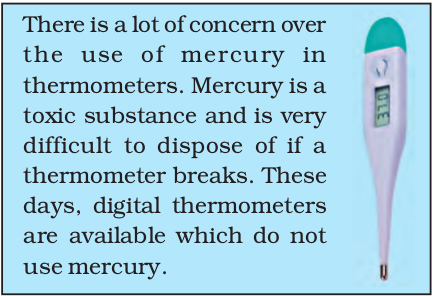
Fig. 4.6 A clinical thermometer has a kink in it
4.4 Transfer of Heat
You might have observed that a frying pan becomes hot when kept on a flame. It is because the heat passes from the flame to the utensil. When the pan is removed from the fire, it slowly cools down. Why does it cool down? The heat is transferred from the pan to the surroundings. So you can understand that in both cases, the heat flows from a hotter object to a colder object. In fact, in all cases heat flows from a hotter object to a colder object.
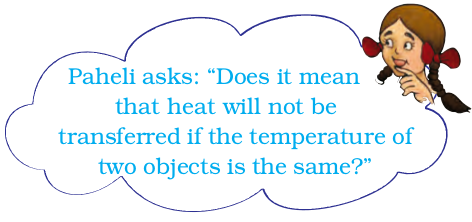
How does heat flow? Let us investigate.
Activity 4.6
Take a rod or flat strip of a metal, say of aluminium or iron. Fix a few small wax pieces on the rod. These pieces should be at nearly equal distances (Fig. 4.7). Clamp the rod to a stand. If you do not find a stand, you can put one end of the rod in between bricks. Now, heat the other end of the rod and observe.
What happens to the wax pieces? Do these pieces begin to fall? Which piece falls the first? Do you think that heat is transferred from the end nearest to the flame to the other end?
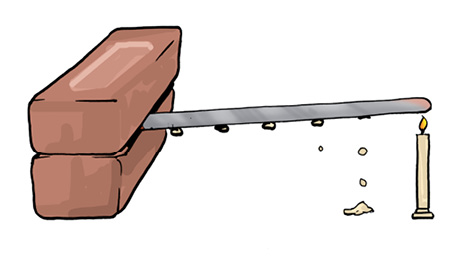
Fig. 4.7 Flow of heat through a metal strip
The process by which heat is transferred from the hotter end to the colder end of an object is known as conduction. In solids, generally, the heat is transferred by the process of conduction.
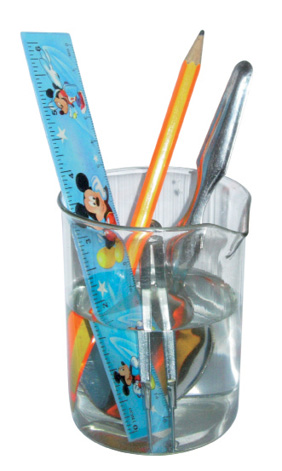
Do all substances conduct heat easily? You must have observed that the metallic pan for cooking has a plastic or wooden handle. Can you lift a hot pan by holding it from the handle without getting hurt?
Activity 4.7
Heat water in a small pan or a beaker. Collect some articles such as a steel spoon, plastic scale, pencil and divider. Dip one end of each of these articles in hot water (Fig. 4.8). Wait for a few minutes. Touch the other end. Enter your observation in Table 4.3.
| Article | Material with which the articles is made of | Does the other end get hot Yes/No |
| Steel spoon | Metal | Yes |
The materials which allow heat to pass through them easily are conductors of heat. For examples, aluminum, iron and copper. The materials which do not allow heat to pass through them easily are poor conductors of heat such as plastic and wood. Poor conductors are known as insulators.
Activity 4.8
Take a round bottom flask (if flask is not available, a beaker can be used). Fill it two-thirds with water. Place it on a tripod, or make some arrangement to place the flask in such a way that you can heat it by placing a candle below it. Wait till the water in the flask is still. Place a crystal of potassium permanganate at the bottom of the flask gently using a straw. Now, heat the water by placing the candle just below the crystal.
Write your observation in your notebook and also draw a picture of what you observe (Fig. 4.9).
When water is heated, the water near the flame gets hot. Hot water rises up. The cold water from the sides moves down towards the source of heat. This water also gets hot and rises and water from the sides moves down. This process continues till the whole water gets heated. This mode of heat transfer is known as convection.
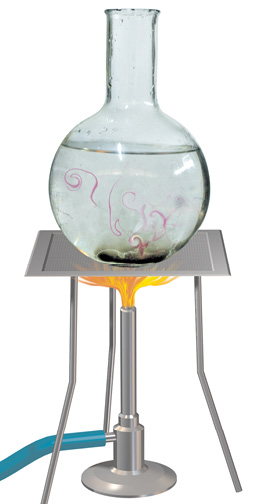
How does the heat travel in air? In which direction does the smoke go?
The air near the heat source gets hot and rises. The air from the sides comes in to take its place. In this way the air gets heated. The following activity confirms this idea.
Activity 4.9
Light a candle. Keep one hand above the flame and one hand on the side of the flame (Fig. 4.10). Do your hands feel equally hot? If not which hand feels hotter? And why?
| Be careful. Keep your hands at a safe distance from the flame so that they do not get burnt. |
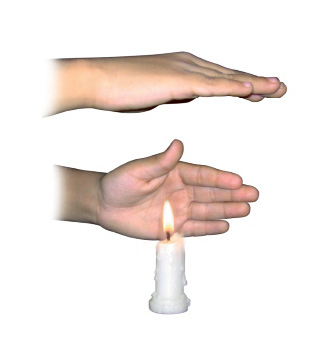
Fig. 4.10 Transfer of heat by convection in air
Notice that towards the top, the air gets heated by convection. Therefore, the hand above the flame feels hot. On the sides, however, there is no convection and air does not feel as hot as at
the top.
The people living in the coastal areas experience an interesting phenomenon. During the day, the land gets heated faster than the water. The air over the land becomes hotter and rises up. The cooler air from the sea rushes in towards the land to take its place. The warm air from the land moves towards the sea to complete the cycle (Fig. 4.11). The air from the sea is called the sea breeze. To receive the cooler sea breeze, the windows of the houses in coastal areas are made to face the sea. At night it is exactly the reverse. The water cools down more slowly than the land. So, the cool air from the land moves towards the sea. This is called the land breeze.
When we come out in the sun, we feel warm. How does the heat from the sun reach us? It cannot reach us by conduction or convection as there is no medium such as air in most part of the space between the earth and the sun. From the sun the heat comes to us by another process known as radiation. The transfer of heat by radiation does not require any medium. It can take place whether a medium is present or not. When we sit in front of a room heater, we get heat by this process. A hot utensil kept away from the flame cools down as it transfers heat to the surroundings by radiation. Our body too, gives heat to the surroundings and receives heat from it by radiation.
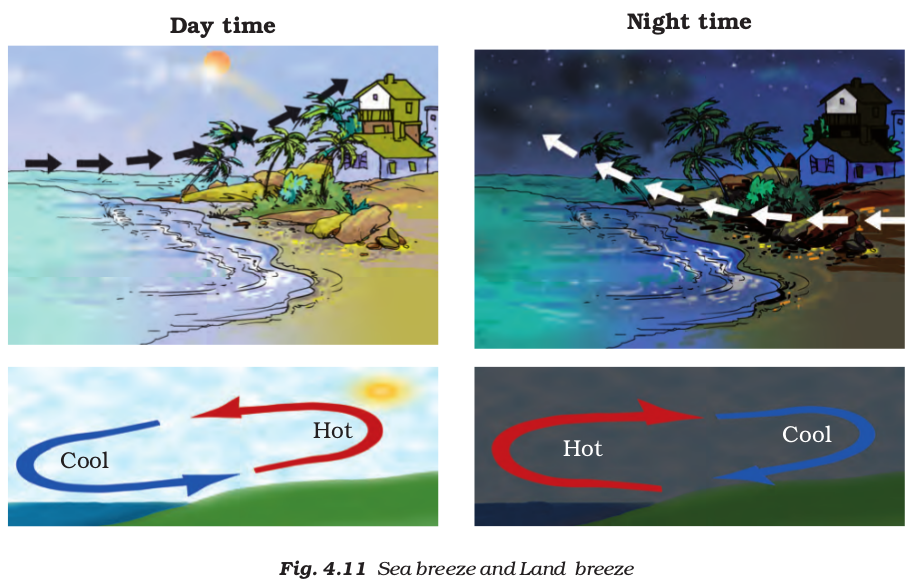
All hot bodies radiate heat. When this heat falls on some object, a part of it is reflected, a part is absorbed and a part may be transmitted. The temperature of the object increases due to the absorbed part of the heat. Why are you advised to use an umbrella when you go out in the sun?
4.5 Kinds of clothes we wear in summer and winter
You know that in summer we prefer light-coloured clothes and in winter we usually wear dark-coloured clothes. Why is it so? Let us find out
Activity 4.10
Take two identical tin cans. Paint the outer surface of one black and of the other white (Fig. 4.12). Pour equal amounts of water in each and leave them in the mid-day sun for about an hour. Measure the temperature of water in both the cans. Do you find any difference in the temperatures? In which can is the water warmer? You can feel the difference even by touching water in the two cans.
| We often use electricity and fuels like coal and wood to keep our houses cool or warm. Is it possible to construct buildings, that are not affected much by heat and cold outside? This can be done by constructing outer walls of buildings so that they have trapped layers of air. One way of doing this is to use hollow bricks, which are available these days. |
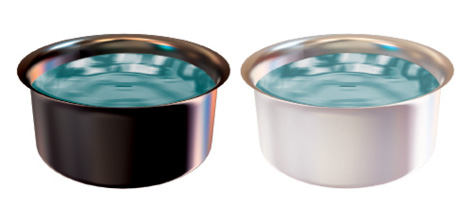
Fig. 4.12 Containers with black and white surface
Activity 4.11
Fill the two cans used in Activity 4.10 with the same amount of hot water at the same temperature (say, at 60oC). Leave the cans in a room or in a shade. Note the temperature of water after 10–15 minutes. Does the temperature of water in both the cans fall by the same amount?
Do these activities suggest to you the reason why it is more comfortable to wear white or light-coloured clothes in the summer and dark-coloured clothes in the winter? Dark surfaces absorb more heat and, therefore, we feel comfortable with dark coloured clothes in the winter. Light coloured clothes reflect most of the heat that falls on them and, therefore, we feel more comfortable wearing them in the summer.
Woollen clothes keep us warm in winter
In the winter, we use woollen clothes. Wool is a poor conductor of heat. Moreover, there is air trapped in between the wool fibres. This air prevents the flow of heat from our body to the cold surroundings. So, we feel warm.
Suppose you are given the choice in winter of using either one thick blanket or two thin blankets joined together. What would you choose and why? Remember that there would be a layer of air in between the blankets.
| Keywords | ||
| Celsius scale | Insulator | Sea breeze |
| Conduction | Land breeze | Temperature |
| Conductor | Radiation | Thermometer |
| Convection |
| What you have learnt |
|
Exercises
1. State similarities and differences between the laboratory thermometer and the clinical thermometer.
2. Give two examples each of conductors and insulators of heat.
3. Fill in the blanks :
(a) The hotness of an object is determined by its __________.
(b) Temperature of boiling water cannot be measured by a _____________ thermometer.
(c) Temperature is measured in degree ______________.
(d) No medium is required for transfer of heat by the process of __________.
(e) A cold steel spoon is dipped in a cup of hot milk. Heat is transferred to its other end by the process of ______________.
(f) Clothes of ______________ colours absorb more heat better than
clothes of light colours.
4. Match the following :
(i) Land breeze blows during (a) summer
(ii) Sea breeze blows during (b) winter
(iii) Dark coloured clothes are preferred during (c) day
(iv) Light coloured clothes are preferred during (d) night
5. Discuss why wearing more layers of clothing during winter keeps us warmer than wearing just one thick piece of clothing .
6. Look at Fig. 4.13. Mark where the heat is being transferred by
conduction, by convection and by radiation.

Fig. 4.13
7. In places of hot climate it is advised that the outer walls of houses be painted white. Explain.
8. One litre of water at 30°C is mixed with one litre of water at 50°C. The temperature of the mixture will be
(a) 80°C (b) more than 50°C but less than 80°C
(c) 20°C (d) between 30°C and 50°C
9. An iron ball at 40°C is dropped in a mug containing water at 40°C.
The heat will
(a) flow from iron ball to water.
(b) not flow from iron ball to water or from water to iron ball.
(c) flow from water to iron ball.
(d) increase the temperature of both.
10. A wooden spoon is dipped in a cup of ice cream. Its other end
(a) becomes cold by the process of conduction.
(b) becomes cold by the process of convection.
(c) becomes cold by the process of radiation.
(d) does not become cold.
11. Stainless steel pans are usually provided with copper bottoms. The reason for this could be that
(a) copper bottom makes the pan more durable.
(b) such pans appear colourful.
(c) copper is a better conductor of heat than the stainless steel.
(d) copper is easier to clean than the stainless steel.
Extended Learning — Activities and Projects
1. Go to a doctor or your nearest health centre. Observe the doctor taking temperature of patients. Enquire:
(a) why she dips the thermometer in a liquid before use.
(b) why the thermometer is kept under the tongue.
(c) whether the body temperature can be measured by keeping the
thermometer at some place other than the mouth.
(d) whether the temperature of different parts of the body is the same or different.
You can add more questions which come to your mind.
2. Go to a veterinary doctor (a doctor who treats animals). Discuss and find out the normal temperature of domestic animals and birds.
3. Wrap a thin paper strip tightly around an iron rod. Try to burn the paper with candle while rotating the iron rod continuously. Does it burn? Explain your observation.
4. Take a sheet of paper. Draw a spiral on it as shown in the Fig. 4.14. Cut out the paper along the line. Suspend the paper as shown in Fig. 4.14 above a lighted candle. Observe what happens. Think of an explanation.
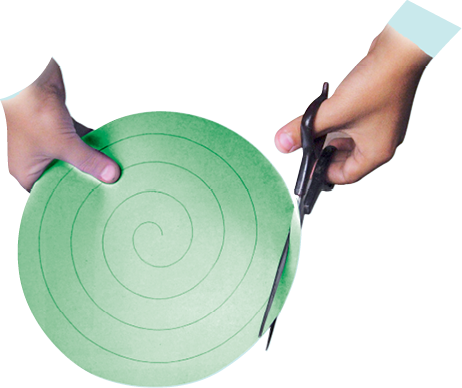
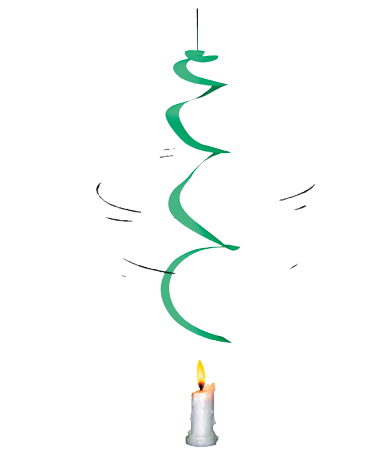
Fig. 4.14
5. Take two similar transparent glass bottles having wide mouths. Put a few crystals of potassium permanganate or pour a few drops of ink in one bottle. Fill this bottle with hot water. Fill the other bottle with cold water. Cover the cold water bottle with a thick piece of paper such as a postcard. Press the postcard firmly with one hand and hold the bottle with the other hand. Invert the bottle and place it on top of the hot water bottle. Hold both the bottles firmly. Ask some other person to pull the postcard. Observe what happens. Explain.
| Did you know? |
The celsius scale was devised by a Swedish astronomer, Anders Celsius in 1742. Strangely, he fixed the temperature of the boiling water as 0°C and of freezing water as 100°C. However, this order was reversed very soon. |